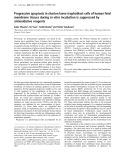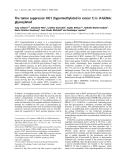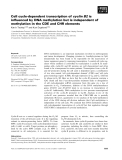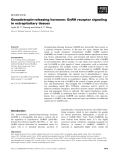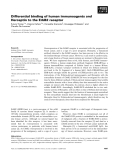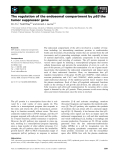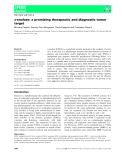
Breast tumors
-
Regulator of G protein signaling (RGS) proteins are gatekeepers regulating the cellular responses induced by G protein-coupled receptor (GPCR)-mediated activation of heterotrimeric G proteins. Specifically, RGS proteins determine the magnitude and duration of GPCR signaling by acting as a GTPase-activating protein for Gα subunits, an activity facilitated by their semiconserved RGS domain. The R7 subfamily of RGS proteins is distinguished by two unique domains, DEP/DHEX and GGL, which mediate membrane targeting and stability of these proteins.
 13p
13p  caothientrangnguyen
caothientrangnguyen
 09-05-2020
09-05-2020
 30
30
 1
1
 Download
Download
-
Breast cancer is the most common cancer among women and the molecular pathways that play main roles in breast cancer regulation are still not completely understood. MicroRNAs (miRNAs) and transcription factors (TFs) are important regulators of gene expression.
 17p
17p  nutifooddau
nutifooddau
 27-01-2019
27-01-2019
 17
17
 3
3
 Download
Download
-
Previously, we demonstrated apoptotic cell death in the chorion laeve trophoblast layer of human fetal membrane tissues during the late stages of pregnancy, the progression of apoptosis during incubation in vitro, and its suppression by a low concentration of glucocorticoid hormones.
 8p
8p  system191
system191
 01-06-2013
01-06-2013
 36
36
 5
5
 Download
Download
-
Human aromatase is responsible for estrogen biosynthesis and is implicated, in particular, in reproduction and estro-gen-dependent tumor proliferation. Themolecular structure model is largelyderived fromtheX-ray structure of bacterial cytochromes sharing only 15±20% identities with hP-450arom. In the present study, site directed mutagenesis experiments were performed to examine the role of K119, C124, I125, K130, E302, F320, D309, H475, D476, S470, I471 and I474 of aromatase in catalysis and for substrate binding....
 13p
13p  research12
research12
 29-04-2013
29-04-2013
 35
35
 3
3
 Download
Download
-
Previous results have shown that theoncoembryonicmarker a-fetoprotein (AFP) is able to induce apoptosis in tumor cells through activation of caspase 3, bypassing Fas-dependent and tumor necrosis factor receptor-dependent signaling. In this study we further investigate the molecular interactions involvedin the AFP-mediatedsignaling of apoptosis. We show that AFP treatment of tumor cells is accompaniedby cytosolic translocation of mitochondrial cytochromec.
 12p
12p  tumor12
tumor12
 20-04-2013
20-04-2013
 46
46
 2
2
 Download
Download
-
Mononuclear phagocytes play a pivotal role in the pro-gression of septic shock by producing tumor necrosis factor-a(TNF-a) andother inflammatorymediators in response to lipopolysaccharide (LPS) fromGram-negativebacteria.Our previous studies have shown monocyte and macrophage activationcorrelatewithchanges inmembranephospholipid composition, mediated by acyltransferases. Interferon-c (IFN-c), which activates and primes these cells for enhanced inflammatory responses to LPS, was found to selectively activate lysophosphatidylcholine acyltransferase (LPCAT) (P...
 7p
7p  fptmusic
fptmusic
 16-04-2013
16-04-2013
 39
39
 2
2
 Download
Download
-
HIC1(hypermethylated in cancer 1) is a transcriptional repressor containing fiveKru¨ppel-likeC2H2zinc fingers and an N-terminal dimerization and autonomous repression domain called BTB/POZ. Here, we demonstrate that full-length HIC1 proteins are modified both in vivo andin vitro with O-linkedN-acetylglucosamine (O-GlcNAc). This is a highly dynamic glycosylation found within the cytosolic and the nuclear compartments of eukaryotes. Analysis of [ 3 H]Gal-labeled tryptic peptides indicates that HIC1 has three major sites forO-GlcNAc glycosylation....
 12p
12p  awards
awards
 05-04-2013
05-04-2013
 55
55
 4
4
 Download
Download
-
Adecrease in the level ofO-acetylatedsialicacidsobserved in colorectal carcinoma may lead to an increase in the expres-sion of sialyl Lewis X , a tumor-associated antigen, which is related toprogressionof colorectal cancer tometastasis. The underlyingmechanism for this reduction is, however, not fully understood. Two enzymes are thought to be primarily responsible for the turnover of O-acetyl ester groups on sialic acids; sialate-O-acetyltransferase (OAT) and sialate-O-acetylesterase (OAE).
 10p
10p  dell39
dell39
 03-04-2013
03-04-2013
 64
64
 5
5
 Download
Download
-
DNA methylation is an important mechanism involved in embryogenesis and tumor development. Changing cytosines to 5-methylcytosines in CpG dinucleotides has been found to be responsible for the inactivation of tumor suppressor genes by repressing transcription.
 15p
15p  media19
media19
 04-03-2013
04-03-2013
 37
37
 2
2
 Download
Download
-
We studied the role of monocyte chemoattractant (MCP)-4⁄CCL13 in the pathogenesis of rheumatoid arthritis (RA). MCP-4 was highly expressed in cartilage from RA patients. Interferon-c significantly stimulated MCP-4⁄ CCL13 production in human chondrocytes, and this effect was enhanced in combination with interleukin-1b or tumor necrosis factor-a.
 9p
9p  media19
media19
 04-03-2013
04-03-2013
 44
44
 2
2
 Download
Download
-
Breast cancer cells exhibit excessive proteolysis, which is responsible for extensive extracellular matrix degradation, invasion and metastasis. Besides other proteases, lysosomal cysteine protease cathepsin B has been impli-cated in these processes and the impairment of its intracellular activity was suggested to reduce harmful proteolysis and hence diminish progression of breast tumors.
 12p
12p  media19
media19
 04-03-2013
04-03-2013
 51
51
 2
2
 Download
Download
-
Tumor protein D52 (TPD52) is a protein found to be overexpressed in prostate and breast cancer due to gene amplification. However, its physio-logical function remains under investigation. In the present study, we inves-tigated the response of the LNCaP human prostate carcinoma cell line to deregulation of TPD52 expression.
 11p
11p  vinaphone15
vinaphone15
 28-02-2013
28-02-2013
 43
43
 1
1
 Download
Download
-
Gonadotropin-releasing hormone (GnRH) has historically been known as a pituitary hormone; however, in the past few years, interest has been raised in locally produced, extrapituitary GnRH. GnRH receptor (GnRHR) was found to be expressed in normal human reproductive tissues (e.g. breast, endometrium, ovary, and prostate) and tumors derived from these tissues.
 17p
17p  vinaphone15
vinaphone15
 28-02-2013
28-02-2013
 39
39
 1
1
 Download
Download
-
Overexpression of the ErbB2 receptor is associated with the progression of breast cancer, and is a sign of a poor prognosis. Herceptin, a humanized antibody directed to the ErbB2 receptor, has been proven to be effective in the immunotherapy of breast cancer. However, it can result in cardiotoxicity, and a large fraction of breast cancer patients are resistant to Herceptin treat-ment.
 13p
13p  vinaphone15
vinaphone15
 28-02-2013
28-02-2013
 45
45
 3
3
 Download
Download
-
Thrombin generation increases in several pathological conditions, including cancer, thromboembolism, diabetes and myeloproliferative syndromes. During tumor development, thrombin levels increase along with several other molecules, including cytokines and angiogenic factors. Under such conditions, it is reasonable to predict that thrombin may recognize new low-affinity substrates that usually are not recognized under low-expression levels conditions.
 13p
13p  viettel02
viettel02
 22-02-2013
22-02-2013
 36
36
 3
3
 Download
Download
-
The endosomal compartment of the cell is involved in a number of func-tions including: (a) internalizing membrane proteins to multivesicular bodies and lysosomes; (b) producing vesicles that are secreted from the cell (exosomes); and (c) generating autophagic vesicles that, especially in times of nutrient deprivation, supply cytoplasmic components to the lysosome for degradation and recycling of nutrients.
 12p
12p  viettel02
viettel02
 22-02-2013
22-02-2013
 33
33
 3
3
 Download
Download
-
Because of the asymptomatic process of carcinogenesis, the early detection of cancers such as hepatocellular carcinoma (HCC) is very challenging. Tumor-prone transgenic mouse models of oncogenesis can provide a stable and powerful tool for the analysis of cancer initiation, and are therefore promising for the discovery of early putative biomarkers of HCC.
 15p
15p  viettel02
viettel02
 19-02-2013
19-02-2013
 31
31
 2
2
 Download
Download
-
Mutations in the tumor suppressor breast cancer susceptibility gene 1 (BRCA1), an important player in the DNA damage response, apoptosis, cell cycle regulation and transcription, confer a significantly elevated life-time risk for breast and ovarian cancer.
 11p
11p  viettel02
viettel02
 19-02-2013
19-02-2013
 51
51
 2
2
 Download
Download
-
he tumor suppressor, breast cancer susceptibility gene 1 (BRCA1), plays an integral role in the maintenance of genome stability and, in particular, the cellular response to DNA damage. Here, the emerging role of BRCA1 in nonhomologous end-joining-mediated DNA repair following DNA dam-age will be reviewed, as well as the activation of apoptotic pathways.
 7p
7p  viettel02
viettel02
 19-02-2013
19-02-2013
 49
49
 3
3
 Download
Download
-
a-enolase (ENOA) is a metabolic enzyme involved in the synthesis of pyru-vate. It also acts as a plasminogen receptor and thus mediates activation of plasmin and extracellular matrix degradation. In tumor cells, EMOAis upregulated and supports anaerobic proliferation (Warburg effect), it is expressed at the cell surface, where it promotes cancer invasion
 0p
0p  cosis54
cosis54
 05-01-2013
05-01-2013
 47
47
 3
3
 Download
Download
CHỦ ĐỀ BẠN MUỐN TÌM











